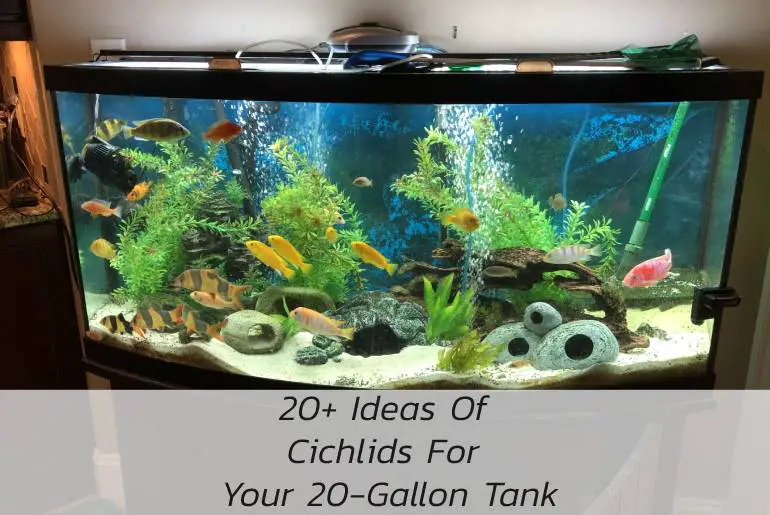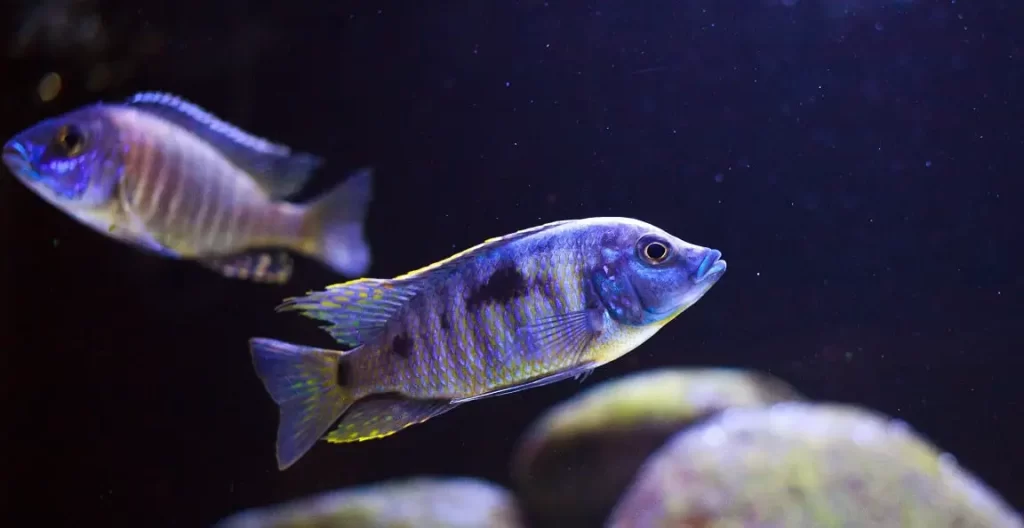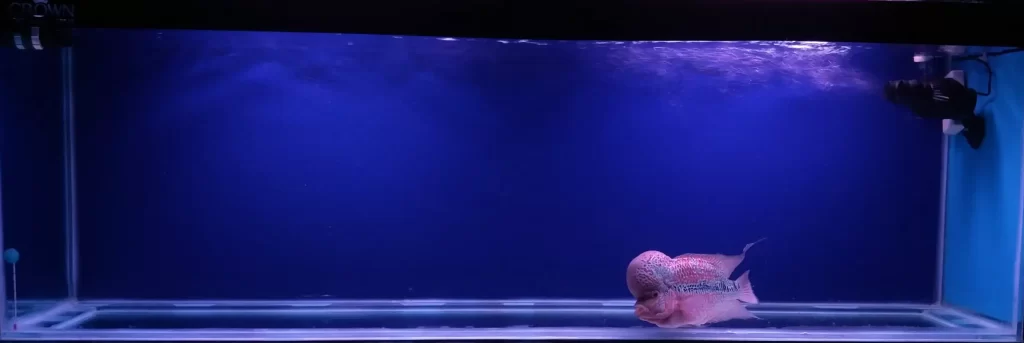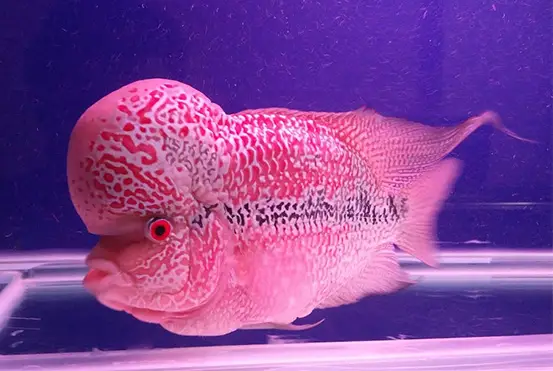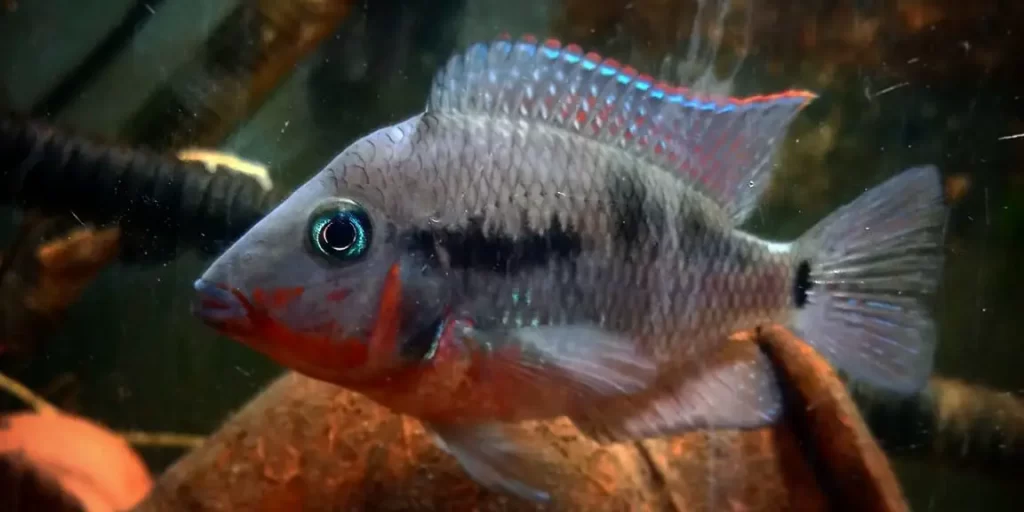If you are an aquarist, getting fascinated by beautiful and colorful fish is not something unusual. Especially if you are one of those, who prefer varieties and colors in your tank. Then, cichlids are perfect for you. Believe me; you will instantly fall in love with them. However, one frequent problem that the owners might face when they keep new fish is whether their tank size will match up to the fish or not. Mostly, people go for a 20-gallon tank at home. So, do cichlids fit in a 20-gallon tank? If they do, then what type of cichlids will we need to keep?
Since cichlids are mostly big, keeping them in the smaller tanks might not be as easy as it is with other fish. But, if you opt for smaller cichlids, few options can do well in a tank as small as 20 gallons. Some American cichlids like Ram cichlids, Dwarf cichlids, Oscar, Firemouth cichlids, and Blue Parrot cichlids. Similarly, a few African cichlids are Julidochromis marksmithi, Lamprologus spp, Altolamprologus spp., Rainbow cribs, and Adorn flag acara.
If you are new to fish keeping and worrying about finding the perfect cichlid for your tank, I am here to help you. So stay tuned, and hopefully, you will for sure make up your mind about the best cichlids that fit your 20-gallon tank.
However, before we dig into the topic, let me briefly tell you what cichlids are!
What Type Of Fish Are Cichlids?
Cichlids are fish from the family Cichlidae. The family contains over 1,300 species making it one of the largest vertebrate families. Cichlids are distributed throughout the world, with most species occurring in Africa and America.
Cichlids are generally freshwater fish, although a few species can tolerate brackish or saltwater for short periods. Most cichlids are omnivorous, although some species are specialized feeders feeding on algae, crustaceans, or other fish.
Cichlids are generally characterized by a single nostril on each side of the head, a small mouth at the end of a short snout, and a laterally compressed body. Usually, they are peaceful fish, although some species can be aggressive, especially when breeding. So, you can’t need to be very careful with the tankmates you keep with them.
Cichlids vary greatly in size, with the largest species(Boulengerochromis microlepis) reaching over three feet in length while the smallest species(Neolamprologus multifasciatus) are less than 2 inches long. They also exhibit a wide range of body shapes and colors. Body shapes range from the elongated torpedo shape of some danio species to the disc-shaped bodies of many African cichlids.
As you know the size of cichlids, what do you think will be the average number of fish you can keep in a 20-gallons tank?
How Many Cichlids In A 20-Gallon Tank?
The number of cichlids you can keep in a 20-gallon tank depends on the specific cichlid species. There are more than 1,300 different species of cichlids, and they vary widely in size. For example, some cichlid species only grow to be a few inches long, while others can reach more than a foot in length.
In general, you can keep one cichlid per 5-10 gallons of water. So, a 20-gallon tank could comfortably hold two to four cichlids, depending on the size of the fish. If you are keeping larger cichlids, you may only be able to keep one or two fish in a 20-gallon tank.
It is important to research the specific species of cichlid that you are interested in keeping before you make a purchase. As per my experience, you can keep around six Lamprologus spp but only two ram cichlids, Apistogramma agassizzi and Julodochromis spp, in 20-gallon tanks.
The number of fish depends on the fish you choose. Thus, it’s up to you!
American Cichlids For 20-Gallon Tank
As we have already talked about it, you can find cichlids worldwide. I believe that the cichlids are popular for their variety and ability to fit in different habitats. Usually, American cichlids are those which are found in the rivers and lakes of South and Central America.
These cichlids are known to be more aggressive than other kinds. So, if you want to keep them in your tank, make sure to provide them with plenty of hiding places and toys to keep them occupied.
Some good choices for a 20-gallon tank include the following:
Regani Dwarf Pike Cichlid (Crenicichla regani)

As the name suggests, Regani Dwarf Pike cichlids are dwarf cichlids and thus one of the smallest cichlids. They are very peaceful fish that prefers soft acidic water. Coming from the Amazon basin, their optimum water temperature must be 75 to 81 deg F. They make a great choice for a 20-gallon tank.
Usually, the average size of most Regnani dwarf cichlids is between 3.5 and 4.1 inches. So, you can keep almost 4 swarf pike cichlids in your 20-gallon tank.
Ram Cichlids
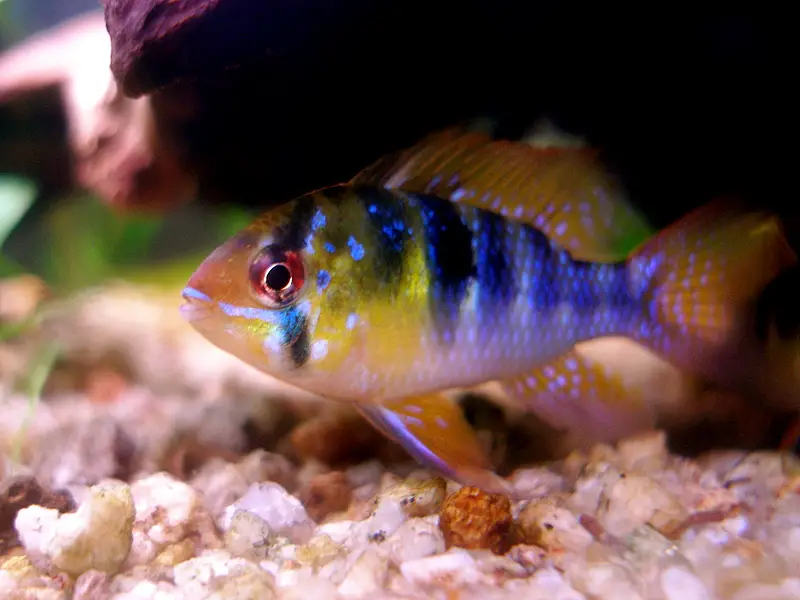
The Ram Cichlid is a relatively peaceful fish that does well in a community tank, as long as it has plenty of hiding places. These fish are native to South America and can grow about 2 to 3 inches long.
Owing to their smaller size, they are a good fit for smaller tanks. Ram Cichlids are best kept in pairs or small groups and do well with other peaceful fish like Tetras, Rasboras, and Danios.
When we talk about the number of ram cichlids best for 20-gallon tanks, I researched it when I was a novice. And I concluded that it is best to keep two females and one male in the 20-gallon tank.
Generally, you will find Ram cichlids too in different types and the most famous ones are:
- Wild Ram Cichlid
- German Blue Ram Cichlid
- Electric Blue Ram Cichlid
- Angel Ram Cichlid
- Golden Ram Cichlid
- Dark Knight Ram Cichlid
- Bolivian Ram Cichlid
Each of them is very beautiful and can be a great fish for any aquarium. You can either keep just a single one or a mixture of all these types to accentuate your tank.
Convict Cichlid (Amatitlania nigrofasciata)
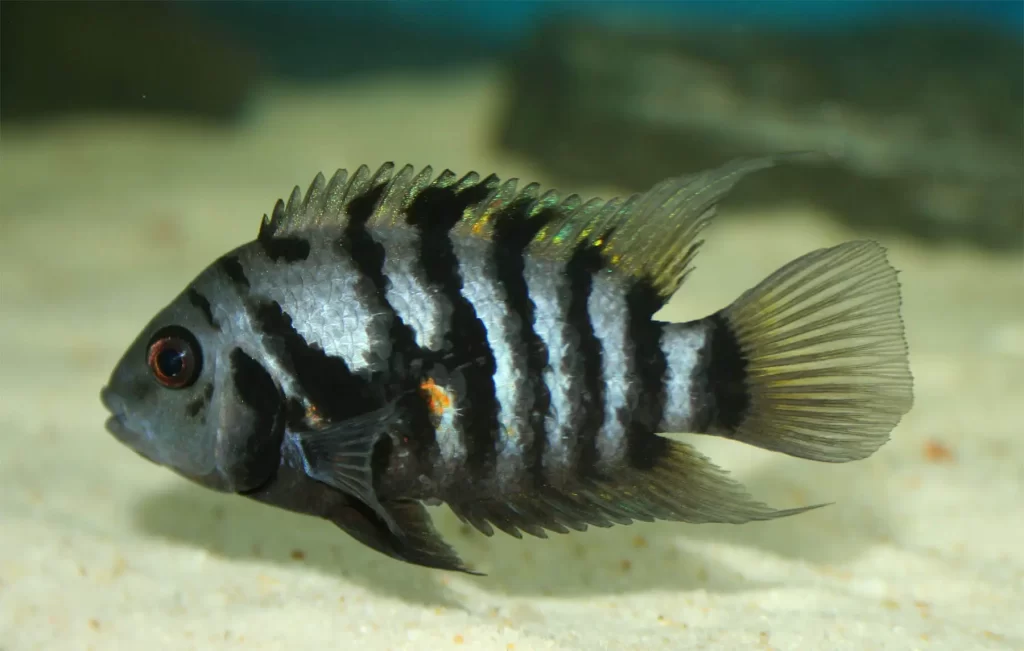
Convict cichlids are one of few species of cichlids that can do quite well in a smaller tank. In addition, they are very beautiful fish that comes in different colors. Thus, they will look magnificent in your tank.
Besides this, these fish are around 4-5 inches long and are quite peaceful compared to other cichlids. I usually like to keep two convict cichlids in my 20-gallon tank. But you keep up to 3. Remember that they are messy eaters, so you will have to do more maintenance on your tank.
Keyhole Cichlids (Cleithracara maronii)

Another great cichlids option for a small tank is Keyhole cichlids. But keyhole doesn’t seem like a unique name? Actually! They are called so because of their ebony keyhole-shaped black striped present on their body. These fish comes from the lower Orinoco River Basin of Venezuela in South America. They are one of the most popular cichlids that you might find in your pet stores.
Owing to the small size of Keyhole cichlids (around 4 inches), you can easily keep around six o them in a 20-gallon tank. If you do not want that many of them, you can even keep 2-3 of Keyholes with some other peaceful fish. They are not aggressive but are hardy. So, they can live comfortably in almost every water condition.
Redbreast Dwarf Acara Cichlid (Laetacara Dorsigera)
Redbreast Dwarf Acara cichlids are one of the smallest cichlids that you will find. They are usually only around 3 inches in size. So, you can easily keep them in a smaller tank. These small little creatures are native to South America. They have a magnificent pastel coloration when they mature and are known for their beautiful color.
Generally, these peaceful fish prefer to live in schools, which can be either of their own or some other peaceful species like tetras, dwarf catfishes, etc. If you have a 20-gallon tank you can easily keep around 6-8 of them. Redbreast Dwarf Acara are omnivorous and can eat anything. Especially, they can be quite aggressive during spawning. So, you must be a little attentive at that period. Otherwise, they can happily live in your tank for around 3 to 8 years if you maintain their diet and environment correctly.
You can also try Blue Acaras.
Ram Cichlids (Mikrogeophagus Ramirezi)

Ram cichlids are a very beautiful multicolored fish that is only about 2.75 inches in size. Sometimes, they will be even smaller. These wonderful fish usually comes from the Orinoco River basin, in the savannahs of Venezuela and Colombia in South America.
Comparatively, ram cichlids are very easy to keep and breed if you fulfill their optimum needs and requirements. Such as water temperature of 81° to 86°F (that must increase in breeding season), and pH less than 5. In addition to this, these small fish are micro predators that mostly enjoy a meaty diet. So, be careful about what you feed them! However, if everything goes well you can easily keep almost 2 to 4 Ram cichlids in a 20-gallon tank.
Dicrossus Warzeli
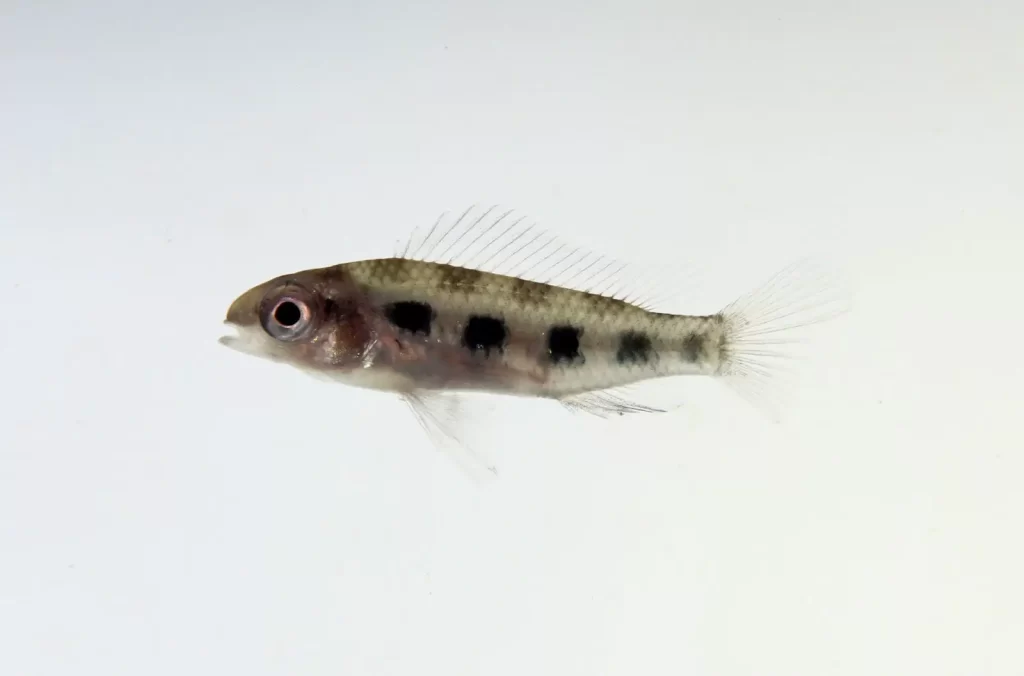
Dicrossus warzeli is a very very small cichlid that is only around 2.5 to 3 inches in size. Besides this small size, these beautiful fish are also quite famous for their dark-spotted bodies. Generally, these spotted cichlids belong to the rivers of the Amazon and Orinoco basins in South America. Therefore, they prefer a water condition that resembles their native habitat to live happily.
Since these cichlids are tiny, you can easily fit them in your 20-gallon tank. But since these fish needs a lot of room to swim and explore, you should not keep more than 4 fish in a tank of 20 gallons. I know some of you might haven’t heard of Dicrossus warzeli, you can find them in any pet stores near you or even order them online.
If you are struggling to keep a perfect fish for your 20-gallon tank, Dicrossus warzeli is a very good option. Just give it a try. I bet you won’t regret it.
Cockatoo Cichlids (Apistogramma Cacatuoides)
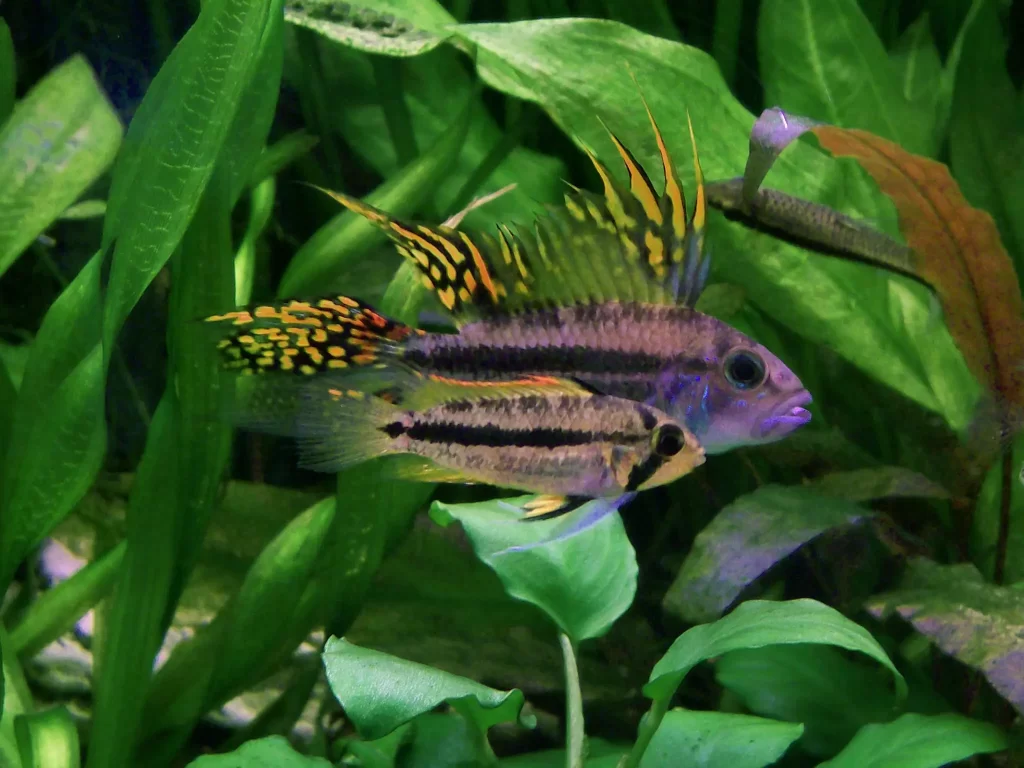
This is a perfect cichlid species for a 20-gallon tank as they are very peaceful and only grow up to 3.5 inches in length. Apistogramma cacatuoides are native to the Amazon River Basin in South America. They prefer living in slow-moving waters with plenty of hiding spots.
You can keep up to 6 of these cichlids in your 20-gallon tank. But make sure that you provide them with enough places to hide because they are very shy fish. These fish like to swim on the top of the tank and can eat anything that fits in their mouth. So, you must be very careful with the tankmates you choose for them.
Apistogramma comes in a wide range of varieties. Some of the species that fit well in a small tank of 20 gallons are A. agassizii, A. rupununi, A. similis, A. paucisquamis, and A. honysloi.
After knowing about all these American cichlids, don’t you want to know about the African cichlids as well? So, let me settle your curiosity and talk about the small African fish.
African Cichlids For 20-Gallon Tank
The cichlids from Africa are quite smaller and peaceful. So, they can be a perfect addition to your 20-gallon tank. These fish are known to be very hardy, so they are ideal for beginner aquarists. African cichlids come in a wide range of colors, so you can definitely find one that will suit your taste.
One thing to keep in mind is that African cichlids are known to be very aggressive, especially during their breeding season. Therefore, you need to ensure that you provide them with enough hiding spots where they can breed.
Moreover, some of the African species that you can keep in your 20-gallon tank are:
Peacock Cichlid (Aulonocara sp.)

The Peacock cichlid is one of the most popular African cichlids that comes from east Africa. They are known to be very peaceful and can grow up to 6 inches in length.
Peacock cichlids are very colorful fish, and they come in a wide range of colors, such as yellow, blue, orange, and red. So, it’s easier to get the one that seems perfect for you. Not only does its color but its small size also makes them quite an excellent fit for indoor tanks.
If you have a small tank of 20-gallon like me, you can keep 4 to 5 peacock cichlids at most in it with ease. But, first, you need to provide them with enough places to hide and some rocks to lay their eggs on.
Umbrella Cichlid (Pseudotropheus demasoni)
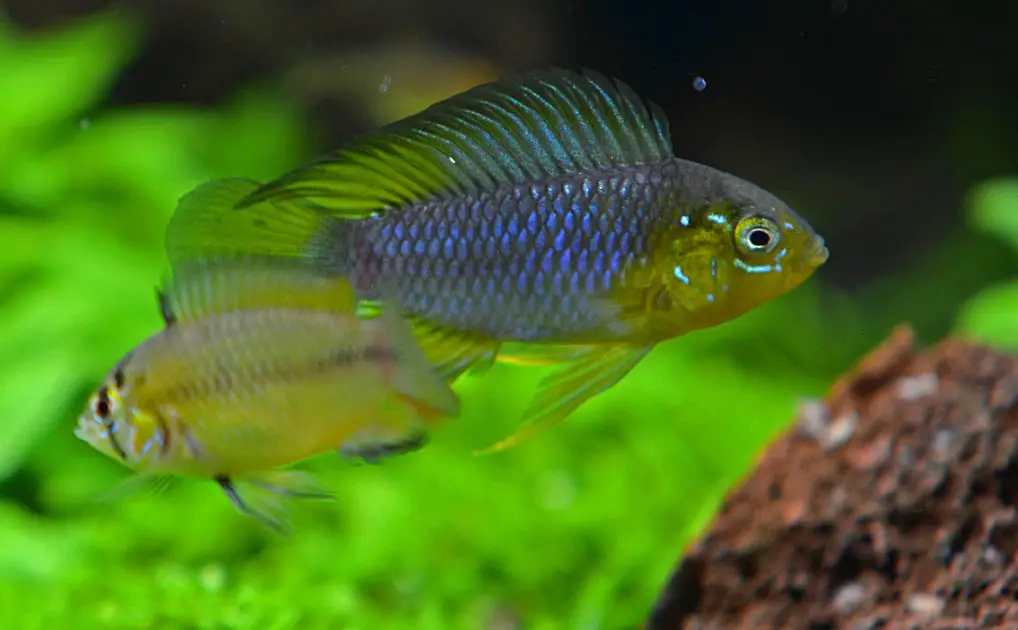
Another excellent choice for your 20-gallon tank is the Umbrella Cichlid. This fish is also known as Demason’s cichlid, and it’s quite popular among beginner aquarists because of its small size and peaceful nature. These cichlids are native to Lake Malawi in Africa, and they prefer living in warm water. So, if you have a heater in your tank, it’s perfect for them.
Umbrella cichlids can grow up to 4 inches in length, and they are quite colorful fish. You can keep up to 6 umbrella cichlids in your 20-gallon tank without any problem. However, this cichlid is a bit more aggressive than the peacock cichlids. So, it’s important to provide them with enough places to hide in the tank.
Kribensis Cichlid (Pelvicachromis pulcher)
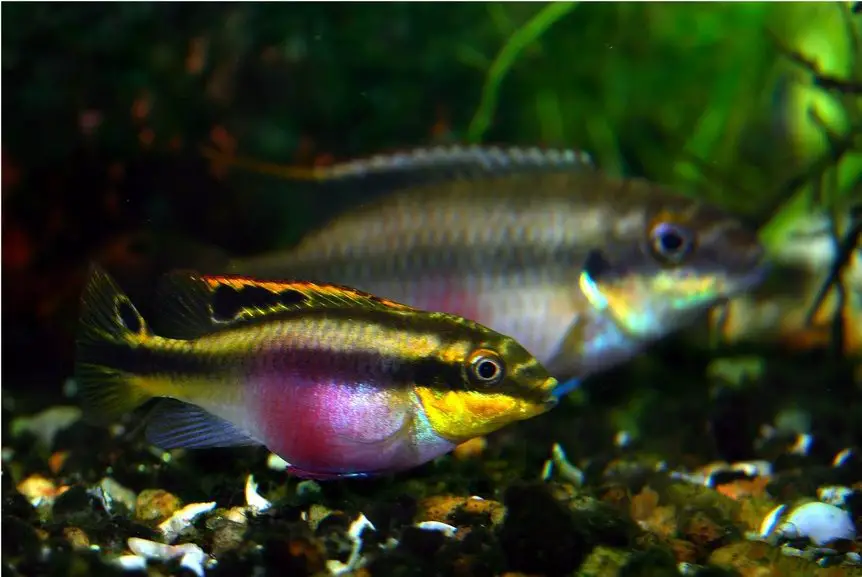
Kribensis Cichlids are popular fish and called Rainbow cribs because of their coloration. They belong to the southern part of Nigeria and the coastal areas of Cameroon in Africa. Usually, these fish enjoy planted tanks with thick vegetation. However, they can be kept in many different levels of water hardness.
The size of males and females differs by just an inch. Male Kribensis cichlids can grow up to 4 inches (10 cm), whereas female fish only grow 3 inches (8 cm). So, you can keep them in a tank of 20-gallons. I suggest you keep just a pair because they can be very aggressive when breeding and need enough space.
Telmatochromis Temporalis

Telmatochromis temporalis is also known as shell dwellers, and it’s a semi-aggressive cichlid. This fish is native to Lake Tanganyika in Africa, and it’s quite popular among beginner aquarists. Telmatochromis temporalis can grow up to 2 inches in length and lives in the bottom of the tank.
These fish are skittish and has a tremendous amount of personality. They are also known to be very good parents. So, if you have a 20-gallon tank, then you only keep a pair of them. Also, make sure to maintain the water with a pH of 8.5 -9 and a temperature of 77-86°F.
Pundamilia Nyererei
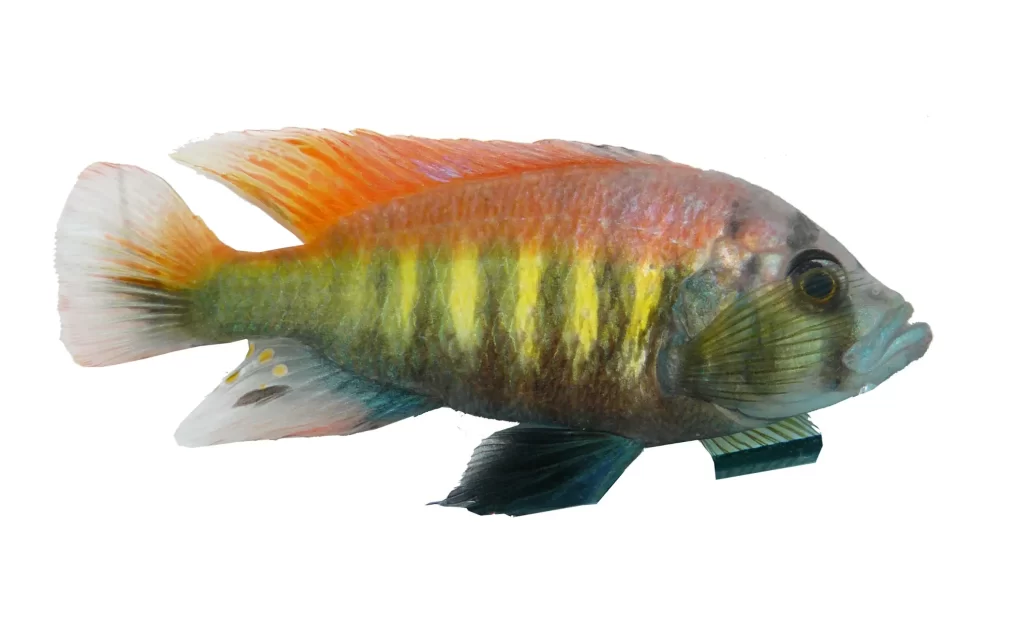
If you are looking for a peaceful and colorful African cichlid, then Pundamilia nyererei is the best choice for you. This fish is also known as Nyerere’s cichlid, and it’s native to Lake Victoria in Africa. Pundamilia nyererei is a small fish and only grows up to 3 to 5 inches in length. These cichlids are very peaceful and can be kept with other peaceful fish.
This cichlid is also quite easy to care for, and it’s perfect for beginner aquarists. So, if you have a 20-gallon tank, you can keep up to 6 of them. Just provide them with plenty of places to hide and some rocks to lay their eggs on.
Julidochromis Marksmithi
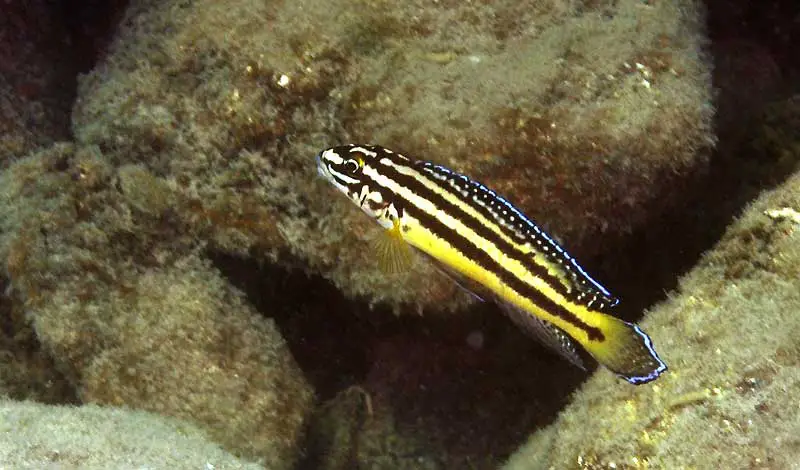
Julidochromis marksmithi is a small and peaceful cichlid. This fish is native to Lake Tanganyika in Africa, and it’s quite popular among beginner aquarists. They are beautiful striped fish that can grow up to 3 inches in length, and it’s a bottom-dwelling fish.
Females are bigger than males, and they are also more aggressive. So, it is best to keep them in a species-specific tank. The males usually hide in the cave when the lights are on and only comes out in the dark.
You can keep around 4 of them in a tank as big as 20-gallons. Just make sure to provide them with plenty of places to hide and some rocks to lay their eggs. Some species of Julidochromis are J.marlieri, J.transcriptus, J.ornatus, J.dickfeldi, etc.
Neolamprologus Brichardi
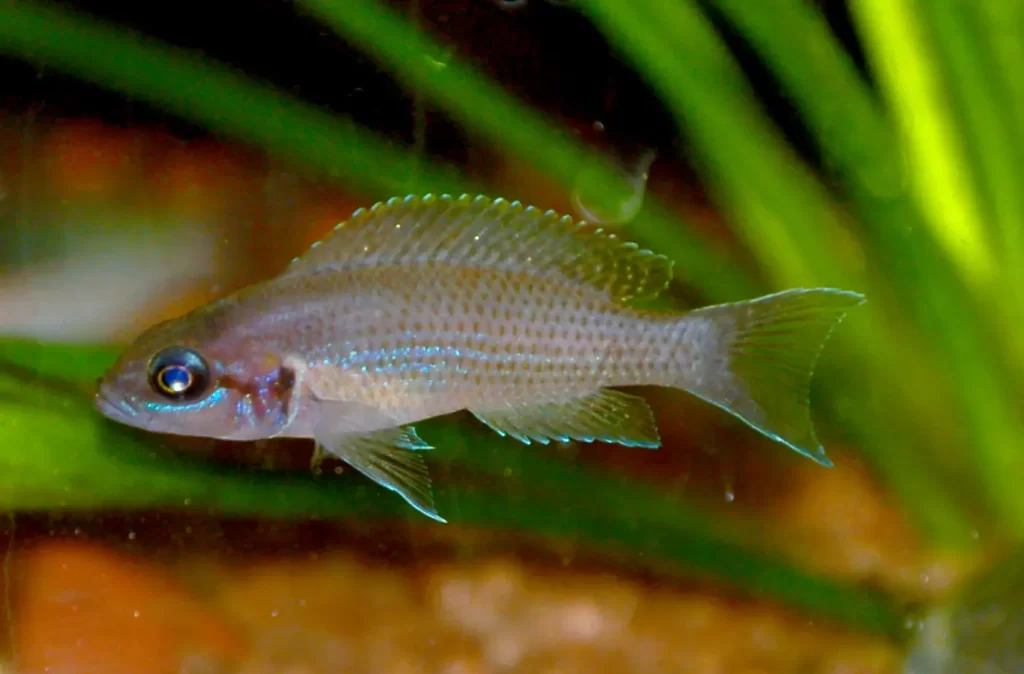
If you are looking for a small and peaceful African cichlid, then Neolamprologus brichardi is the best choice for you. These fish are cave dwellers and usually live in colonies in the wild.
On average, they can be around 2.5 to 3 inches in length, but some specimens can grow up to 4 inches. They are also known as Princess cichlid or Fairy cichlid because of their beautiful coloration. You can keep no more than 6 of them in a 20-gallons tank with sand bottoms.
Altolamprologus Calvus
Altolamprologus calvus is an aggressive cichlid. This fish is native to Lake Tanganyika in eastern Africa, and it’s quite popular among beginner aquarists. They are beautiful dotted fish that can grow up to 4 inches in length, and it’s a bottom-dwelling fish.
These fish are also called sumbu shellfish or zebra shellfish. The male fish are more aggressive than females, and they are also bigger in size. Therefore, you can only keep 4 of them in a tank as big as 20-gallons, followed by enough substrates and plants.
Gymnogeophagus Cichlids
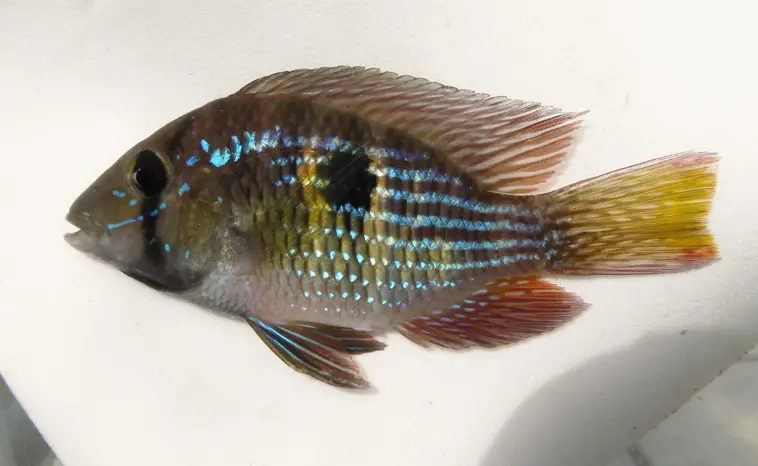
Gymnogeophagus cichlids usually come from the RÍo de la Plata Basin and small coastal basins of Southern Brazil. Their adult size does not exceed more than 4 inches. Therefore, they are the best fit for a community tank and smaller tanks.
Mostly, these fish are a little quarrelsome with rivals and compete for food, shelter, and mating (like G. meridionalis). But If you want a peaceful Gymnogeophagus, G. El Norte is the perfect fish that you should look for. They are very good at a 20-gallon tank and do not cause much trouble. All you need to do is feed them right and maintain their optimum environment. And you can keep almost around 2-4 of them with ease.
Lamprologus
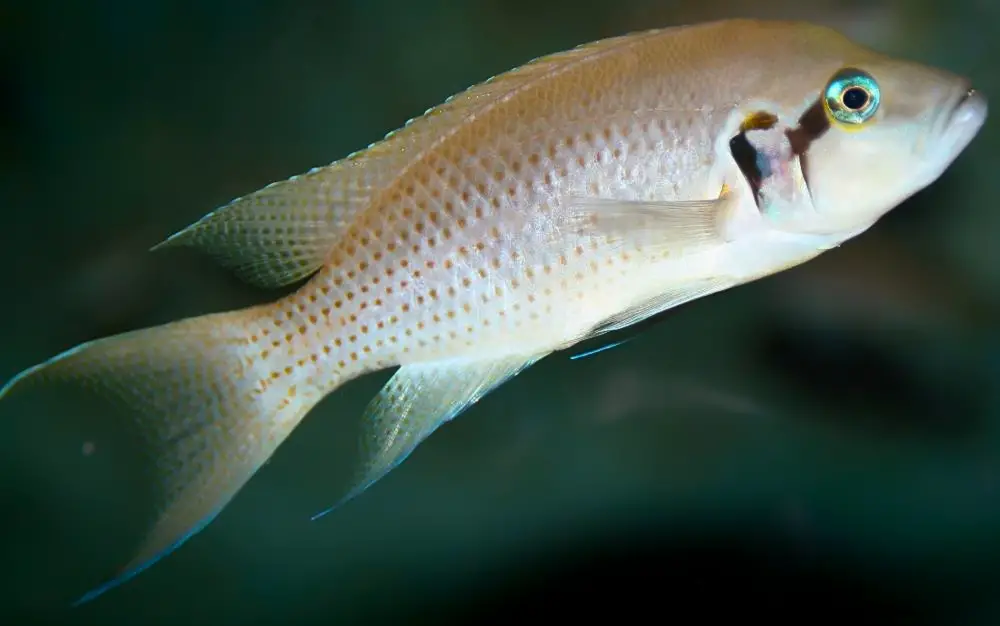
Lamprologus is an aggressive cichlid and not scared of anything. My friends often complained about their fish biting their hands while feeding. Yet, despite their aggression, it’s quite popular among beginner aquarists. I think it’s because of their magnificent body and blue eyes.
Generally, Laprologus is native to Lake Tanganyika in Africa and prefers to live in seashells. So, you need to keep enough seashell substrates if you want to keep this fish. Since these fish are very smaller that grow up to 2.6 inches, you can easily keep around six fish in a 20-gallon tank.
However, I would not recommend keeping this fish with other peaceful fish because they will definitely become the food. The best way to keep this fish is by having a species-only tank. Some popular Laprologus are L.tricola, L.callipterus, L.oscellatus, L.multifasciatus, etc.
Dwarf Flag Cichlid
The Dwarf Flag cichlid is a peaceful fish native to the African Congo region. They are one of the smallest fish that can grow up to 4 inches in length. These fish are highly personable and is great fun to watch.
In general, dwarf flag cichlids live for around 2 to 4 years and need water with pH 6-7.5. They grow well around 71-82 Fahrenheit, and you can keep two of them in a 20-gallon tank.
But you must be careful that these docile fish can be aggressive during the breeding season. So, make sure the tank is well planted and provide hiding spots.
Why Shouldn’t You Keep Bigger Cichlids in 20-Gallon Tank?
Cichlids are fun fish that loves recreational activities. They enjoy swimming around, hiding in caves and chasing each other. So, keeping them in a limited space seems like it would be cruel.
While smaller cichlids generally don’t grow too large, a few species can get quite big. And if you’re keeping them in a 20-gallon tank, they’re going to outgrow it quickly. Once they reach full size, they will start having problems with their health.
They could develop problems with their swim bladder and issues with their joints and bones. Their immune system could also be compromised, making them more susceptible to disease. In short, it’s just not worth the risk to keep bigger cichlids in a 20-gallon tank. It’s better to get a larger tank from the start or stick with smaller cichlid species.
Trust me, I have tried keeping bigger cichlids in a 20-gallon tank, and it is not a pleasant experience for either the fish or the owner. The fish are constantly cramped and stressed, which leads to health problems down the road. So do yourself (and your fish) a favor and get a bigger tank!
What Are The Problems That Cichlids Face In The 20-Gallon Tank?
Except few, cichlids are generally large fish. And the 20-gallon tank is too small for them. So they need at least a 40-gallon tank or anything bigger than that.
The biggest problems with keeping cichlids in a 20-gallon tank are:
Cichlids Will Outgrow The Tank
As I’ve said, cichlids are generally large fish. So, it’s only a matter of time before they outgrow the 20-gallon tank. But, on the other hand, if you keep cichlids like jack Dempsey or Oscar, they will outgrow the tank within 6 to 8 months. So, either you replace their habitat after a few months or keep them in a bigger tank right from the start.
The Tank Will Become Overcrowded
Another problem with keeping big cichlids in a 20-gallon tank is that the tank will become overcrowded very quickly. In addition, as the fish grow, they will need more space.
Even if you only keep one big cichlid in a 20-gallon tank, it will still crowd the tank. These fish need a lot of space to swim and roam around. So, they are not suitable for small tanks like 20 gallons.
Cichlids Will Create too Much Waste.
As you know, fish produce ammonia as a waste product. And ammonia is toxic to fish. So, you have to do a lot of water changes to keep the ammonia levels in check. But, doing too many water changes is not good for the fish either.
You might say that you can use an aquarium filter to remove the waste from the water. But, even the best aquarium filter will not be able to handle the amount of waste produced by a big cichlid.
Cichlids Become Aggressive In Small Tanks
Cichlids are already aggressive by nature. So, they become even more aggressive when you keep them in a small tank. It is because they are stressed out due to the lack of space.
They will start attacking other fish in the tank and even you when you put your hand inside the tank. So, it’s not good to keep these fish in a small tank.
Smaller Tank Increases Stress In Cichlid
The small tank also increases their stress levels because it doesn’t provide them with the proper environment to thrive. The bigger cichlids fail to get the necessary exercise to stay healthy.
Especially, the social tension will be very high in a small tank because these fish are used to living in a large group in the wild. They will struggle to establish their hierarchy in a small tank. So, it’s better to either keep them in a bigger tank or don’t keep them at all.
Smaller Tanks Do Not Provide Enough Air
Another problem with smaller tanks is that they do not provide enough oxygen to the fish. Cichlids require a lot of oxygen to stay healthy. So, when you keep them in a small tank, they might suffocate and die.
My own Jack Dempsey used to live in a 20-gallon tank. But, I had to upgrade him to a 55-gallon tank because he was running out of space. But, even the 55-gallon tank is not enough for him now. He is already 8 inches long and still growing. So, I’m planning to upgrade him to a 75-gallon tank soon.
Higher Susceptibility To Diseases In Smaller Tanks
Cichlids are also more susceptible to diseases in smaller tanks. Again, it is because the water quality deteriorates very quickly in a small tank. And, when the water quality is poor, the fish become stressed and weak. As a result, they are more likely to get sick.
Some of the common diseases that a smaller tank can cause are:
- Fin rot
- Ich
- Hemorrhagic septicemia
- Aeromonas hydrophila
These are just some of the problems you will face if you keep big cichlids in a 20-gallon tank. So, it’s better to either keep them in a bigger tank.
What To Do And Not To Do When You Keep Cichlids In 20-Gallon Tanks?
If you already have a 20-gallon tank and have made up your mind to keep cichlids in it, you can choose any of the options that I have given above. However, besides choosing fish, you also need to take care of some dos and don’ts when you plan to keep fish as beautiful as cichlids.
What Should You Do?
First of all, you need to maintain your tank’s water quality and temperature. The cichlids come from Africa, and they prefer warm water. So, keep the temperature around 78 degrees F. You can use an aquarium heater to maintain the temperature.
Secondly, you need to provide them with a good filtration system. The cichlids are messy eaters, and they produce a lot of waste. So, you need to have a good filtration system to remove the waste from the water.
You also need to provide them with hiding places. The cichlids are shy fish, and they like to hide in the plants or rocks. So, you need to provide them with plenty of hiding places.
Last but not least, you need to provide them with a good diet. The cichlids are omnivorous fish, and they need both plant and animal matter in their diet. So you can give them live food, frozen food, or flakes.
What Should You Not Do?
First of all, you should not keep them with other aggressive fish. The cichlids are aggressive fish, and they will kill other fish in the tank.
Secondly, you should not overfeed them. The cichlids are messy eaters, and they will produce a lot of waste if you overfeed them. So, only give them as much food as they can eat in a few minutes.
Last but not least, you should not change the water too often. The cichlids are sensitive to changes in water quality, and they will not do well if you change the water too often. So, only change the water when it becomes dirty.
These are some things that you need to do and not to do when you keep cichlids in 20-gallon tanks. If you follow these tips, you will be able to keep your cichlids healthy and happy.
Frequently Asked Questions
Which Are The Best Cichlids For Home Aquarium?
There are many different types of cichlids, and it is hard to say which one is the best. But, some of the popular cichlids that people keep in their home aquarium are:
- Angelfish
- Oscars
- Discus
- Electric Blue Hap
- African Cichlids
Do Cichlids Need Light At Night?
Not really! most cichlids prefer to live in seashells or under the cave where there is no light. I would rather suggest you use one so that you can monitor your buddies once in a while. But do not turn it on throughout the day and night. Intense light is not good for your beautiful fish, it affects their eyes.
Can Cichlids Live In Cold Water?
No, cichlids cannot live in cold water. They come from Africa, and they prefer warm water. So, you need to maintain the water temperature in your tank at around 78 degrees F.
Do Cichlids Eat Algae?
Yes, cichlids eat algae. Some of them eat plant matter, and some of them only eat animal matter. However, it all depends on your choice of fish and their preference.
What Are The Tank Requirements For Cichlids?
The tank requirements for cichlids vary depending on the type of cichlid. But, most cichlids need a tank of at least 30 gallons. Some of the bigger cichlids may need 50 gallons or more tank. In addition to this, the cichlids also need hiding places and a good filtration system.
Conclusion
In conclusion, cichlids are beautiful fish that can make a great addition to your home aquarium. But, you need to take care of some things when you keep them in your tank. You need to maintain the water quality and temperature and provide them with a good diet and plenty of hiding places.
Moreover, I request you always keep these fish in a tank of appropriate size. It is best not to force them into a smaller tank as they will not be able to thrive and may even die. Also, do some research before buying them to get the ones that best suit your needs.
I hope you enjoyed reading this article, and I hope it was helpful to you. If you have any questions, please feel free to comment below. Thanks for reading!

